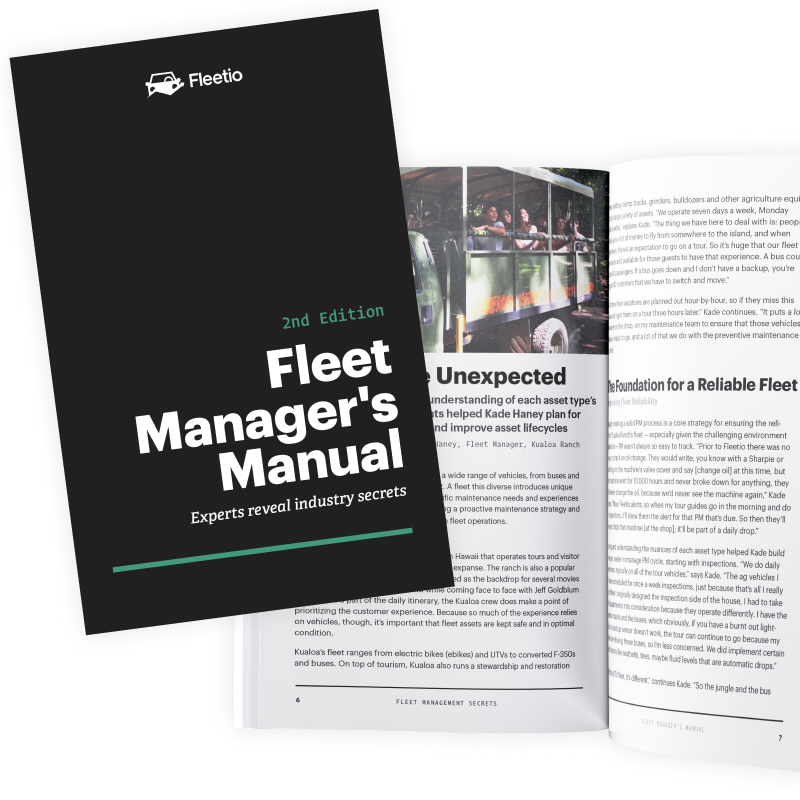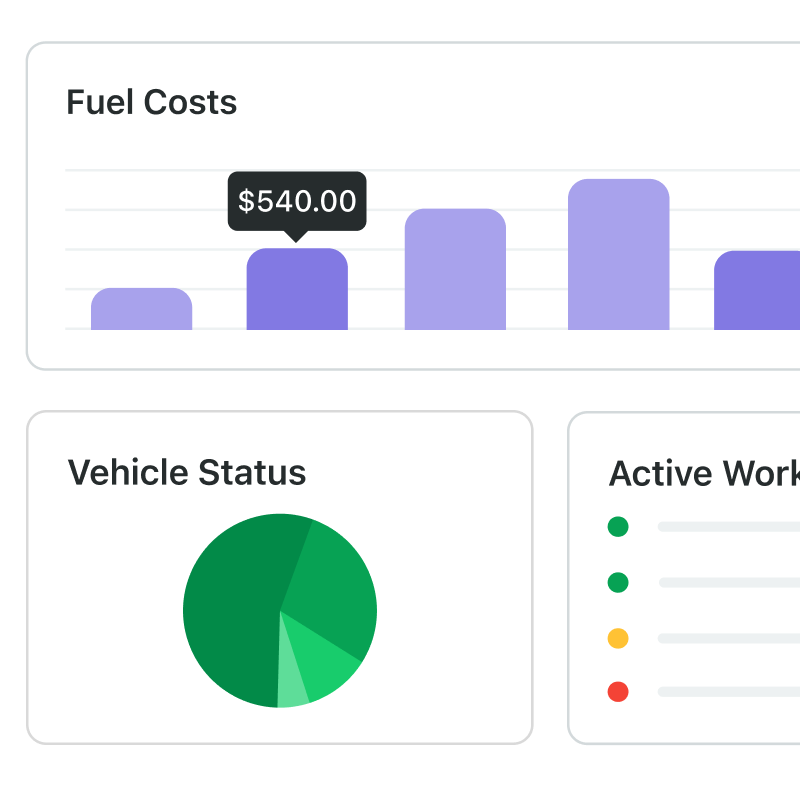What is a Driver Management System? Key Features & Benefits
Managing drivers effectively takes more than GPS tracking. A driver management system gives fleet teams the tools to monitor performance, reduce risk and stay ahead of safety and compliance challenges.
Apr 21, 2025
12 min read

TL;DR: What is a driver management system?
A driver management system (DMS) helps fleets improve safety, reduce risk, and stay compliant by centralizing driver performance data and automating key workflows. It connects tools like telematics, inspections, and behavior tracking to give teams real-time insights and control.
Key components of an effective driver management strategy:
- Digitize inspections: Replace paper DVIRs with mobile-friendly forms to speed up reporting and catch issues early
- Track behavior and performance: Use telematics, dash cams, and driver scorecards to monitor safety and encourage accountability
- Automate compliance management: Centralize licenses, medical cards, and certification tracking to prevent costly violations
- Monitor fuel and mileage: Identify inefficient driving behaviors and route problems to cut waste and reduce fuel spend
- Connect drivers and technicians: Streamline issue reporting and maintenance scheduling through shared platforms
- Enable real-time communication: Use two-way messaging and alerts to keep drivers informed and in sync with the fleet team
- Integrate with fleet systems: Connect your DMS to telematics, fuel, and maintenance tools for a complete view of performance
A connected DMS ensures safer driving habits, better fleet coordination, and fewer compliance headaches - helping teams stay efficient and proactive every mile of the way.
Jump to a topic
What is a fleet driver management system?
A driver management system (DMS) is a set of processes, technologies and tools designed to help fleets monitor, support and improve driver performance. A DMS gives fleet managers the tools to reduce risk, support drivers and maintain safety across all assets, by connecting key data sources (like vehicle inspections, telematics, compliance records and driver behavior analytics) into one centralized system.
While some solutions focus on only one aspect, like GPS tracking or inspections, an effective driver management system integrates multiple data sources for a holistic approach to fleet safety, efficiency, and compliance.
In a recent survey, fleet managers ranked maintenance compliance (80%), promoting a culture of safety (71%), expense tracking and budgeting (68%), and responding to fleet vehicle breakdowns (61%) as their top four responsibilities. All of which require effective driver management to be successful.
A proper driver management system is essential to equipping fleet managers with the tools they need to perform their job effectively.
Benefits of a driver management system for fleet safety and compliance
Managing drivers effectively isn’t just about tracking their movements—it’s about creating a structured, data-driven approach to safety, compliance, and accountability. A driver management system helps fleets stay proactive, reducing risks and improving fleet efficiency across the board.
- Enhance fleet safety. A DMS provides visibility into driver behavior and fleet operations, helping organizations identify risks, enforce policies, and promote a culture of safe driving.
- Improve compliance. With built-in tracking and automation, fleets can maintain accurate records, meet Federal Motor Carrier Safety Administration (FMCSA) and DOT requirements, and avoid costly violations.
- Boost driver accountability. By providing clear performance insights, a DMS encourages drivers to take ownership of their safety, efficiency, and overall impact on the fleet.
- Increase vehicle reliability. When drivers follow proper procedures and report issues in real-time, fleets can prevent small problems from escalating into costly repairs and downtime.
- Enable a real-time feedback loop. With instant access to driver and vehicle data, fleet managers can make informed decisions faster—leading to greater efficiency and cost savings.
Who uses a driver management system?
A driver management system (DMS) isn’t just for fleet managers. It impacts everyone in your operation.
- Fleet Managers need full visibility into driver behavior, vehicle health and compliance data.
- Safety Officers rely on real-time data to identify risks and prevent incidents before they happen.
- Compliance Teams require accurate, automated records to stay ahead of regulations.
- Technicians depend on driver-reported issues to prioritize maintenance and prevent unexpected breakdowns.
- Drivers need easy-to-use tools to track assignments, report vehicle issues and stay compliant.
Time to get your fleet on the right foot
Check out these proven insights from pros in the industry that will help you tackle safety, optimize operations and save big — at every turn.
Let's get after itDriver management system tools and technologies
As mentioned, a true driver management system isn't a single tool. It's a combination of tools and processes to help you monitor, track and improve driver performance. Most fleets rely on solutions from multiple providers, each specializing in different aspects of driver management.
- Dash Cams: Capture real-time driving behavior, provide video evidence and coach drivers.
- GPS Tracking: Monitor vehicle location, optimize routes and ensure compliance with work hours.
- Mobile Apps: Give drivers and fleet managers a central hub for inspections, assignments and alerts.
- Compliance Management: Automate driver qualification tracking, compliance and reporting, to ensure drivers meet FMCSA and U.S. Department of Transportation (DOT) documentation standards across all 50 states.
- Electronic Logging Devices (ELDs): Ensure accurate Hours of Service (HOS) tracking and regulatory compliance.
- Driver Scorecards & Behavior Analytics: Provide data-driven insights into driver safety, efficiency and trends.
- Fuel Management Systems: Identify inefficiencies caused by idling, aggressive driving or poor route planning.
- AI-Powered Risk Detection: Use machine learning to identify distracted driving, hard braking or erratic movements.
- Automated Alerts & Notifications: Ensure drivers stay compliant with reminders for inspections, safety updates and compliance deadlines.
- Two-way Communication Tools: Improve coordination between drivers, technicians and fleet managers.
By integrating these technologies, fleets gain real-time insights into driver performance and safety, allowing for proactive decision-making and a more efficient operation.
How to build a fleet driver management system for your team
A driver management system is not a one-size-fits-all solution. Every fleet has different priorities, whether it’s improving safety, reducing downtime or ensuring compliance. Building an effective DMS starts with clearly defining your goals so you can choose the right tools and processes to support them.
TL;DR: To build an effective driver management system, start by defining your fleet’s top priorities—whether it's safety, compliance, uptime or fuel savings. Then, select tools that support those goals, like behavior monitoring, digital inspections, or fuel tracking. A goal-aligned DMS helps you reduce risk, boost efficiency and improve decision-making across your team.
Define your fleet's goals
Before investing in technology or implementing new processes, it’s important to identify what success looks like for your fleet. A well-designed driver management system should align with your organization’s specific needs and challenges.
- If safety is the top concern, then prioritize tools that monitor driver behavior, such as dash cams and telematics.
- If compliance is a challenge, then focus on automating document tracking and inspection reporting.
- If reducing downtime is critical, then ensure drivers can report vehicle issues easily and that technicians have real-time access to inspection data.
- If fuel costs are rising, then leverage fuel management systems to track inefficiencies and reduce waste.
By clearly outlining your primary objectives, you can build a driver management system that addresses your fleet’s unique pain points and allows you to measure the success of your system.
7 key DMS features for safety, compliance and efficiency
Once you've defined your fleet’s goals, the next step is to identify the key features that will support them. A well-rounded driver management system should include tools that promote safety, efficiency and accountability, while integrating seamlessly with your existing operations.
Here are seven essential features to prioritize when building your system:
1. Support digital inspections for faster, safer workflows
Paper-based inspections slow down workflows and increase the risk of missed defects. A modern driver management system should support electronic driver vehicle inspection reports (eDVIRs), allowing drivers to complete pre- and post-trip inspections digitally, submit issues instantly, and ensure compliance with safety regulations.
2. Track scheduling and assignment history for better driver visibility
To keep operations running smoothly, fleet managers need to know who is driving what and when. A DMS should provide a clear record of driver assignments, including vehicle usage, shift history and job scheduling. This helps optimize resource allocation, reduce vehicle misuse and improve accountability.
3. Connect drivers and shops through a maintenance network
When vehicle issues arise, drivers and technicians need a fast, seamless way to schedule and track repairs. A well-integrated DMS should connect fleets with maintenance providers, whether through an in-house shop or an outsourced network, to reduce downtime and ensure timely repairs.

4. Monitor mileage and fuel usage to reduce waste
Fuel is one of the largest operational expenses for any fleet. A driver management system should include automated mileage tracking and fuel usage monitoring to help fleets identify inefficiencies, reduce idling and optimize routes for better fuel economy.
5. Use vehicle location tracking to improve security and dispatch
Real-time GPS tracking allows fleet managers to monitor vehicle locations, improve dispatching, and enhance route efficiency. It also adds an extra layer of security by helping recover stolen assets and ensuring compliance with work-hour regulations.
6. Centralize driver documents to stay ahead of compliance
Keeping track of licenses, certifications and compliance records manually can lead to costly oversights. In the 2024 CVSA Roadcheck, "No CDL" and "No Medical Card" were two of the three most common driver violations. A DMS with centralized document storage ensures that driver qualifications, medical certifications, and regulatory forms are easily accessible, up to date, and automatically flagged for renewal.

7. Integrate fleet data systems for a complete performance view
A driver management system shouldn’t operate in a vacuum. To maximize its impact, it should seamlessly integrate with other fleet technologies, such as:
- Telematics systems for driver behavior monitoring and real-time tracking
- Maintenance software for vehicle status monitoring, technician communication and issue resolution
- Fuel management systems for expense tracking and optimization
- Compliance tools for regulatory reporting and document management
By ensuring all key data sources are connected, fleets can gain a complete view of driver performance, vehicle health and operational efficiency.
Driver vs. Fleet Management System: What Each Focuses On
| Function | Driver Management System (DMS) | Fleet Management System (FMS) |
|---|---|---|
| Primary focus | Monitoring and improving driver behavior and performance | Overseeing all aspects of fleet operations |
| Key users | Drivers, safety officers, compliance managers | Fleet managers, technicians, finance, procurement |
| Compliance tracking | Driver-specific (licenses, training, HOS, inspections) | Vehicle- and asset-wide (maintenance schedules, registration, insurance) |
| Data insights | Driver scorecards, behavior analytics, incident trends | TCO, asset utilization, fuel spend, maintenance history |
| Communication tools | Two-way messaging with drivers, real-time issue reporting | Work order management, alerts across departments |
| Technology used | Dash cams, mobile apps, GPS, telematics for driver behavior | Maintenance software, fuel tracking, lifecycle analytics |
| Role in safety | Enforces safe driving habits, instant alerts for risky behavior | Ensures vehicles are road-ready, supports proactive maintenance |
| Integration value | Feeds data into fleet-wide decisions via centralized platform | Uses DMS inputs to optimize overall fleet performance |
A DMS enhances an FMS by surfacing real-time, driver-level data – helping fleets tie individual behaviors to overall operational outcomes.
How Fleetio powers driver management systems
While many solutions offer standalone tools, Fleetio serves as a central platform that brings everything together, ensuring seamless collaboration between drivers, technicians and fleet managers.
Before using Fleetio, our drivers had to write on a piece of paper any issues that were on their vehicle. And now they can just take a picture of what the issue is to give the mechanic a full idea of what's wrong with the vehicle. Kathryn Kendrick, United Site Services
Here’s how Fleetio helps streamline driver management:
- Simplifies communication between drivers and technicians. Fleetio eliminates the back-and-forth by digitizing inspections and issue reporting, ensuring that vehicle defects and maintenance needs are addressed quickly.
- Centralizes driver and vehicle data. From inspection reports to driver history and maintenance records, Fleetio provides one place to store, track, and analyze all critical fleet information.
- Automates compliance tracking. With built-in document storage and automated reminders, Fleetio helps fleets stay ahead of regulatory requirements, ensuring driver certifications, inspections, and compliance forms are always up to date.
- Integrates with your existing tools. Fleetio seamlessly connects with telematics providers, fuel management systems, maintenance shop networks, and compliance tools so you can manage everything in one place.
Data integrations for the win
With Fleetio, you can connect all your data in one place, giving you the real-time insights you need to run a smoother, safer, more efficient fleet.
You got thisDriver Management System FAQs
What’s the difference between a driver management system and a fleet management system?
A driver management system (DMS) focuses on monitoring, tracking, and improving driver performance, while a fleet management system (FMS) covers all aspects of fleet operations, including maintenance, fuel tracking, asset management, and more. A DMS is often a core part of an FMS, ensuring that drivers are safe, compliant, and operating efficiently.
Can I build a driver management system without telematics?
Yes, but it may limit your visibility into real-time driver behavior and vehicle tracking. Many fleets start with digital inspections, compliance tracking, and driver scorecards before integrating telematics for more comprehensive data.
How does a driver management system improve fleet safety?
A DMS helps identify and correct unsafe driving behaviors, ensures drivers complete vehicle inspections, and automates compliance tracking to reduce risk. With real-time data and automated alerts, fleet managers can be proactive rather than reactive when it comes to safety.
How can I ensure driver adoption of a new management system?
Driver adoption comes down to ease of use and clear communication. Choose a system with a user-friendly mobile app, provide training and support, and show drivers how the system benefits them—such as making inspections faster, reducing paperwork, and improving vehicle reliability.

Director of Fleet Content, Fleetio
Zach Searcy is the Senior Content Marketing Manager at Fleetio with more than 5 years of experience in the automotive and fleet industries. His content creation days started in middle school when he and his friends began filming lightsaber battles to upload to a new website: 'YouTube.'
LinkedIn|View articles by Zach SearcyReady to get started?
Join thousands of satisfied customers using Fleetio
Questions? Call us at 1-800-975-5304


